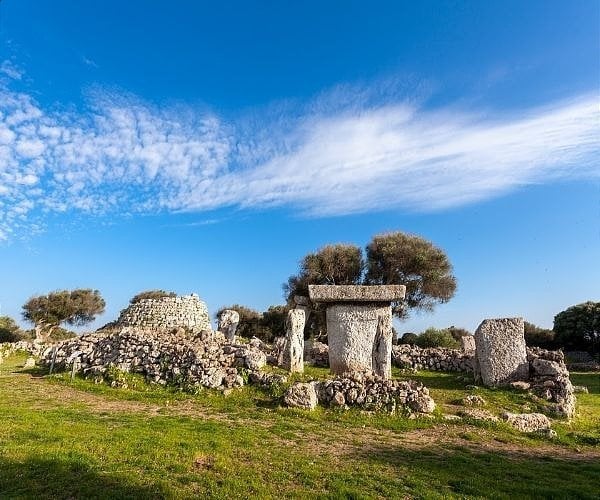Talayotic Menorca declared UNESCO World Heritage site
Talayotic Menorca, the enchanting jewel cradled in the Mediterranean’s azure embrace, has recently garnered the most prestigious of laurels – UNESCO World Heritage status. This accolade shines a brilliant spotlight on the island’s cultural heritage, underscoring its wealth of archaeological wonders that illuminate the intricate tapestry of Menorca’s prehistory.

In this comprehensive voyage of discovery, we extend an invitation to traverse the annals of time. Together, we shall unravel the significance of UNESCO’s imprimatur on Talayotic Menorca, explore the captivating monuments that secured this accolade, and fathom the profound implications for both conservation endeavors and the island’s burgeoning tourism.
A portal to Antediluvian civilization
The hallowed UNESCO imprimatur gracing Talayotic Menorca as a World Heritage Site is an exalted acknowledgment of the island’s role as a guardian of prehistoric culture. At the heart of this recognition lies a splendid ensemble of monuments that eloquently narrate the diverse epochs of Menorca’s prehistoric saga.
What distinguishes Talayotic Menorca is its unwavering commitment to the preservation of these venerable edifices. Anecdotal to this dedication is the exceptional standard of preservation achieved, a testament to the laborious efforts in conservation. As you wander through this open-air chronicle of prehistoric architecture, you shall be captivated by an array of distinctive structures, comprising funerary naves, circular abodes, taulas, and talayots.
Cyclopean marvels unearthed
What truly sets Talayotic Menorca apart is the remarkable showcase it provides of Cyclopean architecture. UNESCO, in its sagacity, recognizes the site as an exemplar of this unique architectural style and its evolution spanning over fifteen centuries. The term “Cyclopean” alludes to the utilization of massive, irregular stones in construction, imparting a singular and awe-inspiring aesthetic. These time-worn structures stand as a testament to the ingenuity of the Talayotic people, offering invaluable insights into their lifestyles during the Bronze Age and Iron Age.
UNESCO’s imprint of authenticity
The proclamation of Talayotic Menorca as a UNESCO World Heritage Site carries far-reaching ramifications, transcending the confines of the island. Adolfo Vilafranca, the luminary president of the Menorcan Council, exudes an air of pride in expressing, “Menorca is once again cast into the global limelight as a culturally significant destination.”
IMPORTANT NOTICE:
If you are reading this article anywhere other than on A Luxury Travel Blog, then the chances are that this content has been stolen without permission.
Please make a note of the web address above and contact A Luxury Travel Blog to advise them of this issue.
Thank you for your help in combatting content theft.
The UNESCO imprimatur resonates as an affirmation of Menorca’s embodiment of universal values, authenticity, and integrity. The island now stands tall as a lodestar for exemplar practices in the realm of archaeological heritage preservation. This distinction arrives after a thirty-year interlude following Menorca’s designation as a Biosphere Reserve, endowing it with the distinguished honor of being one of the few locales worldwide possessing the dual World Heritage status bestowed by UNESCO. The Menorcan populace, in their collective heart, swells with pride for their cherished heritage, and this recognition serves as a testament to their unwavering dedication to its conservation.
A fillip for conservation and scholarly inquiry
Beyond the veneer of prestige and pride associated with UNESCO’s benediction, this distinction translates into tangible benefits for Talayotic Menorca. Its elevation to the global stage is anticipated to draw increased international attention, promising a surfeit of resources earmarked for the conservation and scholarly exploration of these venerable monuments and the culture they enshrine.
This proclamation, as an echo through the annals of history, also underscores the tireless toil of conservationists in the Balearic Islands, safeguarding the relics of antiquity. It spotlights the unwavering commitment of local authorities and communities towards the preservation of these priceless vestiges for posterity.
A constellation of UNESCO treasures
Talayotic Menorca’s UNESCO World Heritage status is merely one luminous gem adorning the diadem of the Balearic Islands. The region, a veritable trove of cultural and natural wonders, boasts an additional quartet of UNESCO distinctions that enhance its allure. In Mallorca, the Serra de Tramuntana and the Song of Sybil are enshrined in UNESCO’s embrace. Meanwhile, Menorca basks in the dual glory of being a Biosphere Reserve and a World Heritage Site. Ibiza, famed for its fortified acropolis in Dalt Vila and the marine expanse adorned with oceanic Posidonia prairies (seagrass), stands as another of the Balearics’ UNESCO-ensconced treasures.
This newfound global acknowledgment not only safeguards the past but also ushers in a promising era of exploration, preservation, and cultural enrichment. The UNESCO World Heritage status of Talayotic Menorca beckons as an opportunity to immerse in the timeless allure of a bygone era, an indelible legacy destined to captivate and inspire generations yet unborn.
Did you enjoy this article?
Receive similar content direct to your inbox.


Probably for the best that Talayotic Menorca has been given UNESCO heritage status to raise its profile as I expect that a lot of people like me have probably never heard of it!
I’ve always wondered what the criteria for UNESCO heritage are. There are lots of questions. Why does it take so long for some sites to be recognised?
Yet another good reason to visit Menorca, my favourite island in the Med.
Guess what? It’s my favourite Mediterranean island too. It must be around 30 years ago that I first visited when I was young and single.
Then when we had young children we took them a few times for beach holidays and they still talk about those times.
Now as empty-nesters who can go where we please we’re thinking about a Menorca trip next Spring.
How much history could those stones tell? In their own way they are a portal into the past.
When I travel I love doing the research to find out about the region’s stories. For me it’s a big part of the fascination of travel.